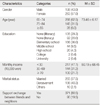Abstract
Purpose
This descriptive study was done to develop a predictive model of depression in rural elders that will guide prevention and reduction of depression in elders.
Methods
A cross-sectional descriptive survey was done using face-to-face private interviews. Participants included in the final analysis were 461 elders (aged≥ 65 years). The questions were on depression, personal and environmental factors, body functions and structures, activity and participation. Decision tree analysis using the SPSS Modeler 14.1 program was applied to build an optimum and significant predictive model to predict depression in rural elders.
Results
From the data analysis, the predictive model for factors related to depression in rural elders presented with 4 path-ways. Predictive factors included exercise capacity, self-esteem, farming, social activity, cognitive function, and gender. The accuracy of the model was 83.7%, error rate 16.3%, sensitivity 63.3%, and specificity 93.6%.
Figures and Tables
References
1. Aihara Y, Minai J, Aoyama A, Shimanouchi S. Depressive symptoms and past lifestyle among Japanese elderly people. Community Ment Health J. 2011; 47(2):186–193. http://dx.doi.org/10.1007/s10597-010-9317-1.
2. Cho MJ, Bae JN, Suh GH, Hahm BJ, Kim JK, Lee DW, et al. Validation of geriatric depression scale, Korean version (GDS) in the assessment of DSM-III-R major depression. J Korean Neuropsychiatr Assoc. 1999; 38(1):48–63.
3. Choi HJ. Depression and cognitive function of the elderly using the welfare facilities for the aged in the community. J Korean Acad Public Health Nurs. 2006; 20(2):119–129.
4. Delmater R, Hancock M. Data mining explained: A manager's guide to customer-centric business intelligence. Boston, MA: Digital Press;2001.
5. Folstein MF, Bassett SS, Anthony JC, Romanoski AJ, Nestadt GR. Dementia: Case ascertainment in a community survey. J Gerontol. 1991; 46(4):M132–M138.
6. Jeon HS, Kahng SK. Predictors of depression trajectory among the elderly: Using the Korean welfare panel data. J Korean Gerontol Soc. 2009; 29(4):1611–1628.
7. Kang DK. A study on the classification criteria between urban and rural area. J Agric Ext Commun Develop. 2009; 16(3):557–586.
8. Kim BK. Correlational study between physical activity and depression and cognitive function among elderly people. Seoul: Yonsei University;2003. Unpublished master' thesis.
9. Kim DB, Sohn ES. A meta-analysis of the variables related to depression in elderly. J Korean Gerontol Soc. 2005; 25(4):167–187.
10. Kim KB, Sok SR. Factors influencing depression of the elderly. J Korean Acad Community Health Nurs. 2009; 20(2):197–206.
11. Kim OS, Yang SJ, Kim JH, Kim NY, Jeon HO. Leisure activities, cognitive function and depression in female elderly. J Korean Acad Adult Nurs. 2007; 19(3):436–446.
12. Kim YJ. Mediating effects of social supports on the decrease of depression of the rural elderly. J Welf Aged. 2009; 46:77–104.
13. Kim YS, Yoo MS, Park JH. Factors influencing depression in community-dwelling elderly with low income. J Korean Gerontol Soc. 2009; 29(4):1313–1325.
14. Lee DY, Lee KU, Lee JH, Kim KW, Jhoo JH, Youn JC, et al. A normative study of the mini-mental state examination in the Korean elderly. J Korean Neuropsychiatr Assoc. 2002; 41(3):508–525.
15. Lee HS. Health status and utilization of long-term care facility in the urban and rural aged. J Korean Acad Community Health Nurs. 2008; 19(2):260–269.
16. Lee YH. The impact of familial risk factors on the psycho-social effects of elder abuse. Korean J Fam Soc Work. 2003; 11:35–57.
17. Lee YH, Lee KJ, Han GS, Yoon SJ, Lee YK, Kim CH, et al. The development of physical functioning scale for community-dwelling older persons. Korean J Prev Med. 2002; 35(4):359–374.
18. Ministry of Health and Welfare. 2008 living profiles and welfare service needs of older persons in Korea survey. Seoul: Ministry of Health and Welfare;2009.
19. Moon MJ. Factors influencing depression in elderly people living at home. J Korean Acad Nurs. 2010; 40(4):542–550. http://dx.doi.org/10.4040/jkan.2010.40.4.542.
20. Nam KM, Park HJ. The influence of participation in religious and social activities of the elderly on their life satisfaction: Focusing on depression and death anxiety. J Welf Aged. 2010; 49:405–427.
21. Rho BI, Mo SH. The effect of levels and dimensions of social support on geriatric depression. J Korean Gerontol Soc. 2007; 27(1):53–69.
22. Rosenberg M. Society and the adolescent self-image. Princeton, NJ: Princeton University Press;1965.
23. Sheikh JI, Yesavage J. Geriatric depression scale (GDS): Recent evidence and development of a shorter version. In : Brink TL, editor. Clinical gerontology: A Guide to assessment and intervention. New York, NY: Routledge;1986. p. 165–173.
24. Shin KR, Jung D, Jo I, Kang Y. Depression among community-dwelling older adults in Korea: A prediction model of depression. Arch Psychiatr Nurs. 2009; 23(1):50–57. http://dx.doi.org/10.1016/j.apnu.2008.03.001.
25. Shmueli G, Patel NR, Bruce PC. Data Mining for business intelligence:Concepts, techniques, and applications in microsoft office excel with XLMiner. Hoboken, NJ: John Wiley and Sons;2006.
26. Song MS, Kim SK, Kim NC. A study on the correlation between elderly women' depression and physical fitness. J Korean Biol Nurs Sci. 2011; 13(1):37–43.
27. St John PD, Blandford AA, Strain LA. Does a rural residence predict the development of depressive symptoms in older adults? Can J Rural Med. 2009; 14(4):150–156.
28. Statistics Korea. 2010 agriculture, forestry & fishery census report. Daejeon: Statistics Korea;2011.
29. Suh GH, Kim JK, Yeon BK, Park SK, Yoo KY, Yang BK, et al. Prevalence and risk factors of dementia and depression in the elderly. J Korean Neuropsychiatr Assoc. 2000; 39(5):809–824.
30. World Health Organization. International classification of functioning, disability and health (ICF). 2001. Retrieved August 16, 2010. from http://www.who.int/classifications/icf/en/.




 PDF
PDF ePub
ePub Citation
Citation Print
Print






 XML Download
XML Download